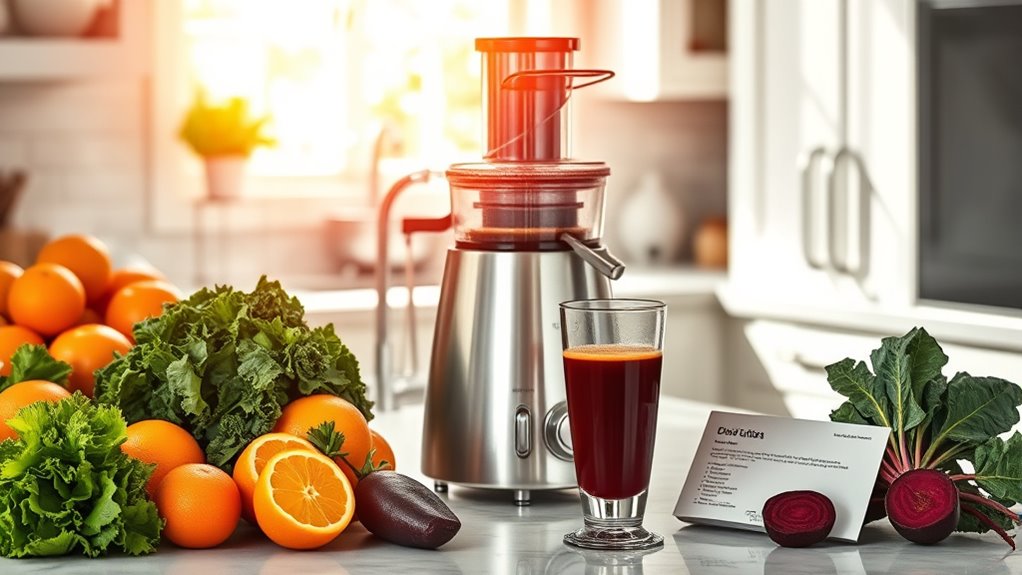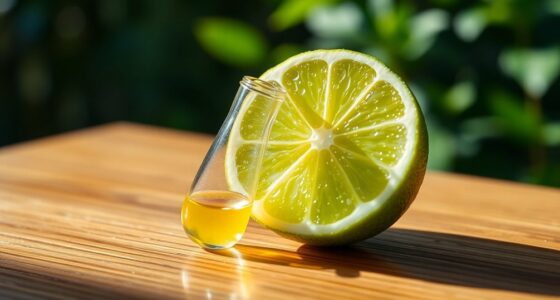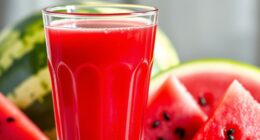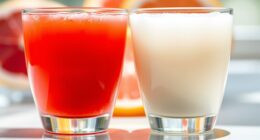One common juicing mistake can seriously impact your health: relying too heavily on high-sugar fruits. If you’re loading up your juices with sweet fruits, you risk insulin spikes and unwanted cravings. It’s vital to balance your ingredients and incorporate plenty of organic vegetables while limiting sweet fruits to just one per juice. This way, you’ll promote better nutrient absorption and avoid potential weight gain. Stick around to uncover more essential tips for healthier juicing practices!
Key Takeaways
- Overconsumption of high sugar fruit juices can lead to insulin spikes and increased cravings, jeopardizing your health.
- Failing to incorporate organic vegetables diminishes the nutritional value of your juice and can lead to oxalic acid build-up.
- Ignoring the timing of juice consumption can hinder nutrient absorption, so always drink on an empty stomach.
- Not consuming freshly made juice within 15 minutes may result in a loss of essential nutrients and enzymes.
- Neglecting to balance ingredients by limiting sweet fruits and rotating greens can affect overall health benefits.
Understanding the Role of Vegetables in Juicing
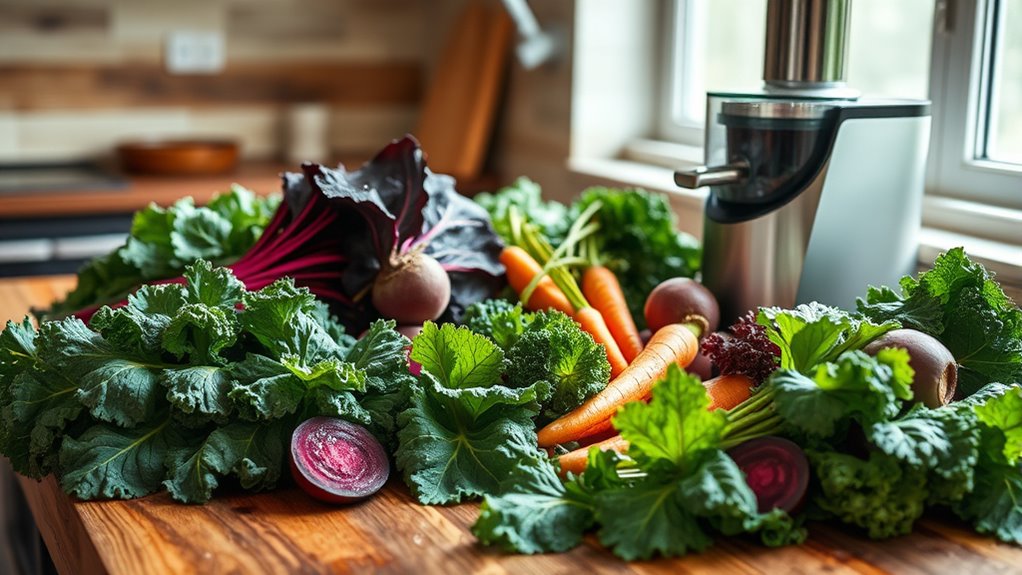
When you engage in juicing, understanding the role of vegetables is crucial for maximizing your health benefits. Incorporating a variety of organic vegetables into your vegetable juices not only boosts their nutritional profile but also helps prevent oxalic acid build-up from specific greens like spinach.
Dark leafy greens such as kale and collards are packed with important nutrients, providing concentrated sources that juicing allows for easier absorption. By limiting sweet vegetables like carrots and beets to just one per juice, you can manage blood sugar levels and avoid insulin spikes.
This balance guarantees you get high amounts of nutrients without compromising your health. Remember, whole fruits and vegetables are great, but vegetable juices can elevate your wellness journey even further. Additionally, vegetable juices like celery and cucumber are excellent options for keeping carbohydrate intake low while providing essential vitamins.
The Dangers of High Sugar Fruit Juices
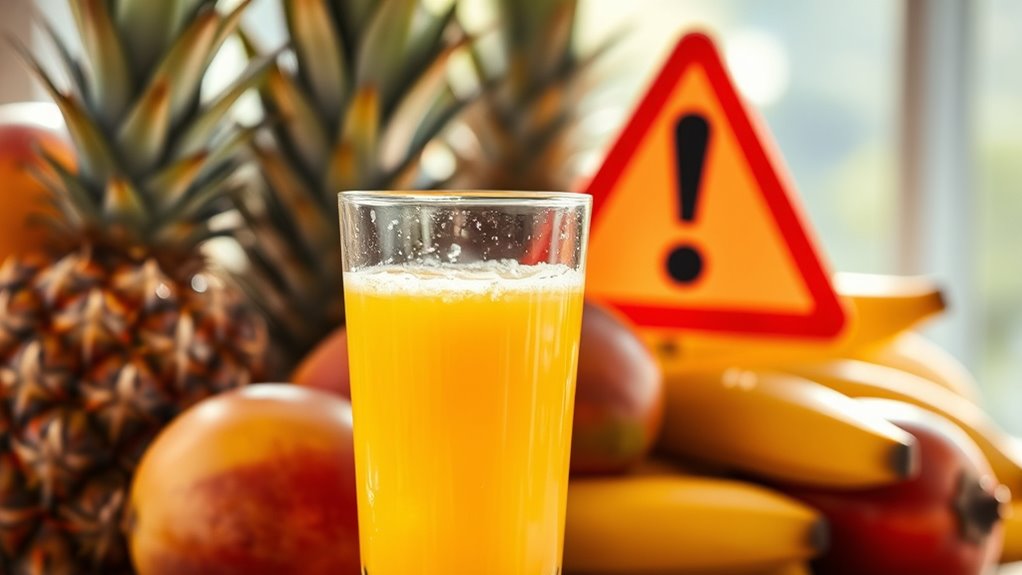
While incorporating vegetables into your juicing routine is important, it’s equally essential to be aware of the potential pitfalls of using high sugar fruit juices. These juices can cause spikes in insulin levels, leading to increased cravings and possible weight gain.
To maintain balanced sugar intake, limit sweet fruits like apples and carrots to just one per serving. Consuming fruit juices on an empty stomach can further amplify sugar absorption, so be cautious with your choices.
Opt for low-sugar options like lemons and limes to keep your juice flavorful without the excess sugar. Gradually reducing fruit content, especially for kids, helps them adapt to green juices while ensuring they still benefit from vitamins and minerals found in whole foods. Additionally, balancing your diet with gout-friendly foods can help manage overall health and prevent sugar-related issues.
Optimizing Nutrient Absorption Through Timing
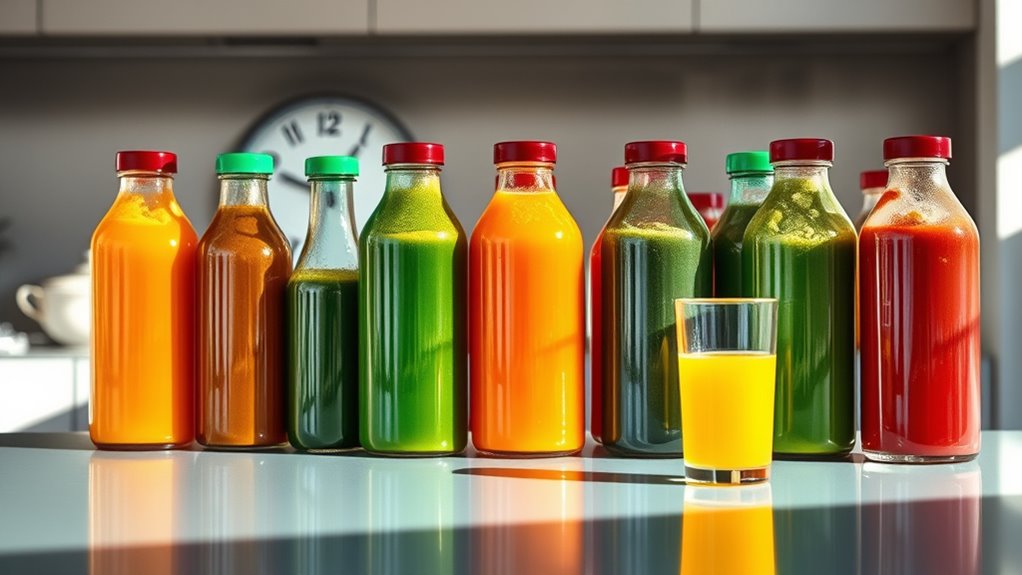
To get the most out of your juice, drink it on an empty stomach for maximum nutrient absorption. It’s also important to wait at least two hours after a meal before having your juice to avoid digestive discomfort. Timing your juice consumption can greatly enhance its benefits and keep your energy levels steady. Additionally, consuming juice can provide a concentrated source of vitamins and antioxidants that support overall wellness.
Empty Stomach Benefits
Drinking fresh juice on an empty stomach can greatly enhance nutrient absorption, allowing your body to swiftly utilize vitamins and minerals without interference from other foods.
When you drink juice before a meal, you maximize its nutritional benefits, boosting your energy levels and overall health. It’s best to wait at least two hours after a meal to avoid digestive issues like heartburn.
Consuming fresh juice within 15 minutes of preparation guarantees you get the live enzymes your body craves. To further optimize nutrient assimilation, wait about 20 minutes after drinking juice before eating.
This practice not only helps curb cravings for unhealthy foods but also keeps you feeling satisfied and energized throughout the day. Additionally, juices rich in vitamins A, C, and E promote skin health, making juicing a holistic approach to wellness. Enjoy the benefits of juicing wisely!
Meal Timing Guidelines
Understanding meal timing can greatly enhance your juicing experience, especially when it comes to optimizing nutrient absorption. For the best results, drink fresh juice on an empty stomach, ideally two hours after your last meal. This timing allows your body to absorb nutrients efficiently without interference.
If you wait about 20 minutes after juice consumption before eating, you can also help prevent digestive issues like heartburn. Remember, consuming juice right after a meal can lead to discomfort, as your body isn’t prepared to absorb nutrients effectively. Additionally, drinking juice made from whole fruits can further improve nutrient intake by providing essential vitamins and minerals that may be lost in the juicing process.
Finally, treat juice as a supplement or snack rather than a meal replacement to support your digestive health, maximizing benefits without overwhelming your system.
Freshness Matters: The Importance of Immediate Consumption

While you might enjoy the convenience of storing juice for later, consuming it immediately after juicing is imperative to reaping its full nutritional benefits. Freshly made juice should ideally be drunk within 15 minutes, as live enzymes start to diminish quickly.
If you do need to store juice, keep it in an airtight container and consume it within 24-36 hours for slow juicers or 72 hours for press juicers to maintain quality. Refrigeration is essential to prevent bacteria growth, so always store juice properly.
Drinking it on an empty stomach allows for ideal nutrient absorption, ensuring you get those health benefits. Additionally, incorporating meal replacement juices can help provide essential nutrients while supporting your weight loss journey. Remember, prioritizing freshly made juice over pre-made options is critical for maximizing your wellness.
Balancing Ingredients for Maximum Health Benefits

Freshly made juice is just the beginning of your journey toward ideal health; what you put into that juice plays a significant role too. To maximize your health benefits, balance your ingredients wisely.
Rotate greens like kale, spinach, and collards weekly to avoid oxalic acid build-up, and incorporate various fruits or vegetables to broaden your nutrient intake. Limit sweet fruits to one per serving to keep sugar in check, preventing insulin spikes while enjoying essential Vitamin C.
Consider eating whole fruits alongside your juices for extra grams of fiber, enhancing digestion. Finally, emphasize organic ingredients when possible to boost nutritional quality and reduce pesticide exposure. To further enhance your juice’s nutritional profile, consider adding chia seeds, which are rich in omega-3s and fiber, contributing to overall health.
This mindful approach guarantees you’re truly reaping the rewards of your juicing efforts.
Common Misconceptions About Juicing and Nutrition

Many people mistakenly believe that all juice is inherently healthy, overlooking the fact that excessive sugar from sweet fruits can cause insulin spikes and cravings. While it’s great to drink juice, remember it shouldn’t replace whole foods.
Juicing should complement your diet, not serve as a meal replacement. With juicing, fiber is removed, which can lead to quick energy but also leaves you wanting more.
You might think smoothies are better, but both offer unique benefits; juicing allows for higher antioxidant levels and faster nutrient absorption.
Moderation is key—juices can be nutritious when consumed with enough fruits and vegetables. Incorporating chia seeds’ high fiber content can help enhance your overall nutrient intake and support digestive health.
Finally, fresh juice isn’t always best immediately; it can last 24-72 hours if stored correctly.
Frequently Asked Questions
Can Juicing Cause Health Problems?
Yes, juicing can cause health problems if you’re not careful.
Drinking juice right after a meal might lead to digestive issues, like heartburn. If you consume juices high in sugar, you could spike your insulin levels, leading to cravings and potential weight gain.
Additionally, storing juice too long can reduce its nutrients, while not rotating your greens may cause oxalic acid build-up.
It’s crucial to juice mindfully and maintain a balanced approach.
Is There Scientific Evidence to Support Juicing for Health?
Juicing isn’t just a fad; it’s a powerhouse of nutrients!
Scientific evidence shows that juicing can boost your vitamin absorption, reduce inflammation, and even help you shed those pesky pounds.
Plus, it encourages you to chow down on a rainbow of fruits and veggies, improving your overall diet.
Regularly sipping that fresh juice might even lower your blood pressure and cholesterol levels.
What Is One Downside About Juicing?
One downside about juicing is that it can spike your blood sugar levels. When you juice fruits and vegetables, you strip away their fiber, which helps regulate sugar absorption.
If you tend to use sweet fruits or rely on juice as a meal replacement, you mightn’t get enough nutrients from whole foods.
Additionally, pre-made juices often contain added sugars or preservatives, which can further diminish their health benefits.
What Is the 80/20 Rule for Juicing?
Imagine building a vibrant garden where 80% of the plants are nutrient-rich vegetables, while the remaining 20% are sweet fruits.
That’s the essence of the 80/20 rule for juicing! You’re aiming for a juice blend that primarily features vegetables, which helps you minimize sugar intake and stabilize your energy.
Conclusion
In the world of juicing, think of your health as a garden; the right mix of vegetables and fruits can yield a bountiful harvest of benefits. By avoiding high-sugar fruits and optimizing your juicing routine, you’re not just sipping a drink but nurturing your well-being. Remember, freshness and balance are your allies in this journey. So, cultivate your knowledge and craft your juices mindfully, and watch your health flourish like vibrant blooms in spring!
Cindy thoroughly researches juicing trends, techniques, and recipes to provide readers with practical advice and inspiration. Her writing style is accessible, engaging, and designed to make complex concepts easy to understand. Cindy’s dedication to promoting the advantages of juicing shines through her work, empowering readers to make positive changes in their lives through the simple act of juicing.

